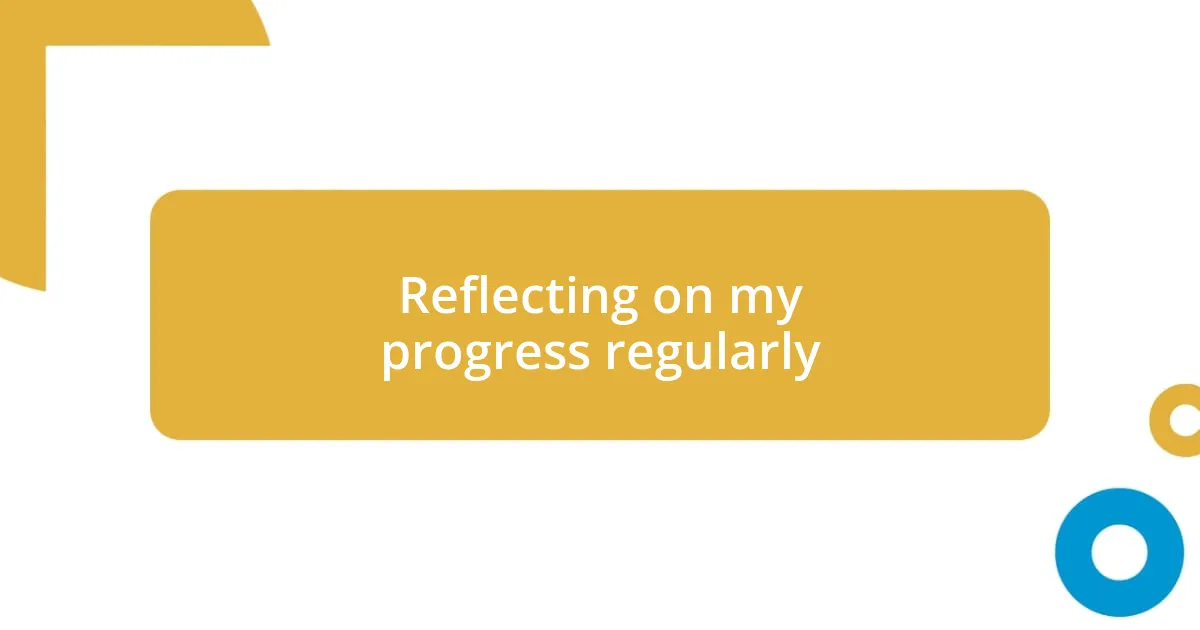Key takeaways:
- Transitioning from complex language to clarity was essential for engaging readers effectively.
- Identifying weaknesses like overuse of jargon and passive voice highlighted the need for a more active writing style.
- Experimenting with different writing styles and techniques fostered personal growth and authenticity in writing.
- Regular reflection and seeking peer feedback significantly enhanced the understanding and quality of my writing.

Understanding my initial style
Understanding my initial writing style was like peeling back the layers of an onion. I often leaned heavily on jargon and complex sentences, thinking that sophisticated language would impress readers. In reality, it often left them scratching their heads, wondering what I was trying to say.
I remember a time I submitted a piece brimming with elaborate terminology. I was met with confusion, not admiration, which was an eye-opener for me. Have you ever faced a similar moment where you realized your communication wasn’t landing? That experience pushed me to reflect and adapt, prioritizing clarity over complexity.
A key takeaway for me was the importance of connection. I wanted my readers to feel engaged, not overwhelmed. It was in those moments of realization that I understood my initial style had to evolve if I truly wanted to resonate with my audience—after all, isn’t writing about sharing ideas and forging connections?

Identifying weaknesses in my writing
Identifying weaknesses in my writing often felt like standing in front of a mirror and not liking what I saw. I noticed I relied too much on passive voice, which made my arguments feel weak and lifeless. One example that stands out is when I submitted an article that failed to convey urgency, leading to a lukewarm response. That moment sparked a realization that I needed to take charge of my voice and engage my audience actively.
Here are some specific weaknesses I identified in my writing:
– Overuse of jargon: I often used technical terms without explaining them, alienating many readers.
– Wordiness: My tendency to over-explain led to convoluted sentences that obscured my main points.
– Lack of structure: Some of my pieces felt like a maze without clear direction, making it tough for readers to follow my arguments.
– Failure to connect: At times, I focused too much on the content rather than how it resonated with my audience’s emotions and experiences.
– Ignoring editing: I would rush through revisions, which meant I sometimes missed glaring mistakes that disrupted flow and clarity.

Researching different writing styles
Researching different writing styles opened my eyes to the vast landscape of possibilities. Initially, I had no idea how varied writing could be—ranging from the concise journalistic style to the vivid storytelling of creative writing. I remember diving into articles and books that dissected different approaches, and it felt like unlocking a treasure chest of ideas. Have you ever found yourself inspired by a particular author’s style? For me, it was a game-changer, sparking experimentation and encouraging me to step outside my comfort zone.
As I explored various writing styles, I compared their strengths and weaknesses, reflecting on how each could enhance my craft. For instance, the clarity of the expository style contrasted sharply with the emotional depth found in narrative writing. In doing so, I discovered that understanding these distinctions allowed me to tailor my approach based on the purpose of my piece. It’s remarkable how a shift in style can transform the reader’s experience—what style do you find resonates most with you?
I also delved into the importance of tone and voice in different writing styles. Some styles require a formal tone, while others thrive on conversational warmth. In one of my explorations, I stumbled upon a blog post that utilized humor to convey serious concepts. The way the author balanced levity with substance slapped a smile on my face while making the ideas stick. It highlighted for me that engaging writing could evoke emotions—something I initially overlooked. As I experimented with these variances, I learned to harness my unique voice, paving the way for more authentic connections with my readers.
| Writing Style | Description |
|---|---|
| Expository | Focuses on informing or explaining a topic clearly and succinctly, often devoid of personal opinion. |
| Narrative | Tells a story with emotional depth and character development, engaging the reader’s empathy. |
| Descriptive | Uses vivid imagery and sensory details to paint a picture, immersing the reader in the experience. |
| Persuasive | Aims to convince the reader of a particular viewpoint, utilizing strong arguments and emotional appeals. |

Practicing new techniques regularly
Practicing new techniques regularly became a cornerstone of my writing evolution. I remember dedicating a week to focus solely on reducing wordiness in my sentences. It was challenging at first—like squeezing a balloon too tightly—but eventually, I learned to express ideas more clearly without losing their essence.
One memorable exercise was writing a series of short paragraphs, each with a different style. It felt like trying on various outfits, some surprisingly flattering and others not quite right, but each taught me something valuable. I thought, “How can a simple shift in technique transform my message so profoundly?” It’s fascinating to discover that experimenting with structure can make even mundane topics captivating.
As I incorporated these techniques into my routine, I felt a surge of excitement. Every new method I practiced felt like finding a piece of a puzzle, gradually revealing a clearer picture of my writing style. A breakthrough moment came when I tried incorporating more active voice; it breathed life into my words! The thrill of seeing my ideas connect with readers in a more powerful way pushed me to continue exploring and honing my craft.

Seeking feedback from peers
Seeking feedback from peers has been a transformative experience for my writing journey. I vividly recall a time when I shared a draft with my friend, who, much to my surprise, pointed out a recurring tendency to overuse certain phrases. At first, I felt a pang of defensiveness, but then I realized that this insight was like finding a hidden flaw in a beautiful painting. Have you ever experienced a moment where feedback has propelled you to a new level of insight?
One of the most valuable lessons I learned from seeking peer feedback is the importance of perspective. In one instance, a fellow writer suggested restructuring my introduction for greater impact. I was skeptical, feeling attached to my original version, yet his enthusiasm for the new approach ignited my curiosity. When I applied his suggestions, the piece transformed into a more engaging narrative. It made me think—how often do we cling to our first drafts, fearing to let go of what we initially created?
Another memorable experience was participating in a local writing group where we critiqued each other’s work. The diversity of opinions was eye-opening. I remember one participant describing my work as “evocative yet unclear,” which prompted me to delve deeper into the emotions I conveyed—as if peeling back the layers of an onion. Their feedback helped me become more attuned to how my words resonated with others, highlighting that writing is not just about what I want to say but how it connects with readers. Isn’t it fascinating how collaboration can illuminate aspects of our craft we might otherwise overlook?

Implementing changes in drafts
Implementing changes in drafts is perhaps one of the most exhilarating parts of my writing process. After completing a draft, I often find myself diving back into the text with fresh eyes. I recall a particular instance when I revisited a story after letting it sit for a week. The changes I made seemed almost instinctive—trimming extraneous details and sharpening my language felt like sculpting a block of marble into something beautiful. Isn’t it remarkable how time away from your work can bring clarity?
As I started embracing this revision mindset, I realized the importance of asking specific questions about my drafts. I would ponder things like, “Is this paragraph serving its purpose?” or “Am I truly engaging the reader’s emotions?” These questions were pivotal in leading me to dissect my writing. I once edited a piece I initially thought was nearly perfect—only to discover entire sentences that didn’t quite resonate. It’s fascinating how a little introspection can uncover hidden opportunities for improvement.
One technique I’ve found particularly effective is reading my drafts aloud. The first time I did this, I was shocked at how some phrases fell flat, while others sang. It was like listening to a musician play; I could hear the rhythm of my words. Sometimes, I would even record myself and listen to the playback. Did you know that this practice not only helps catch awkward phrasing but also enhances the emotional cadence of my writing? It’s those little surprises that often lead to my most significant breakthroughs.

Reflecting on my progress regularly
Regularly reflecting on my progress has become an invaluable habit that I treasure. I often find myself reviewing my past work, and it’s surprising how my perception of my writing has evolved. There have been moments when I looked back at older pieces and felt a mixture of embarrassment and pride. It’s as if I was revisiting an old journal, remembering my thoughts and feelings while realizing how far I’ve come. Have you ever felt a bittersweet connection to your previous creations?
One exercise I enjoy is setting aside time each month to jot down what I’ve accomplished and learned. This practice often uncovers patterns in my writing that I hadn’t noticed before. For instance, I recently spotted a recurring theme of vulnerability in my storytelling. Reflecting on this revelation made me consider how much my experiences have shaped my narrative voice. It’s fascinating to examine how our life influences our words, isn’t it?
Moreover, I’ve found that sharing my reflections with fellow writers enriches the experience. During a casual catch-up with a mentor, I recounted my journey and the insights I’d gained. Their thoughtful questions pushed me to dig deeper into my reflections. I realized then that self-reflection isn’t just an individual exercise; it can thrive in a communal atmosphere. When was the last time you shared your progress with someone? You might be amazed by the new layers your reflections can reveal through another’s perspective.














